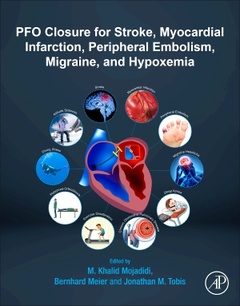Description
Patent Foramen Ovale Closure for Stroke, Myocardial Infarction, Peripheral Embolism, Migraine, and Hypoxemia
Coordinators: Mojadidi M. Khalid, Meier Bernhard, Tobis Jonathan M.
Language: English
Subject for Patent Foramen Ovale Closure for Stroke, Myocardial...:
Keywords
Acute limb ischemia; Air aspiration; Atrial fibrillation; Atrial septal aneurysm; Atrial septal defect; Bubble study; Carcinoid heart disease; Carcinoid syndrome; Carcinoid; Chiari network; Chronic obstructive pulmonary disease; CLOSURE I trial; Contrast medium; Coronary embolism; Coronary vasospasm; Cryptogenic stroke; Decompression illness; Decompression sickness; Device closure; Device position; Device selection; Echocardiographic guidance; Embolic stroke of undetermined source; Embolism; Embryology; Eustachian valve; Fluoroscopic guidance; Foam sclerotherapy; Follow-up imaging; High-risk PFO; History; Hypoxemia; ICE; Informed consent; Interventional treatment; Intracardiac echocardiogram; Left atrial appendage closure; Lipomatous hypertrophy; Metaanalysis; Migraine headache with aura; Migraine headache; Migraine with aura; Migraine without aura; Migraine; MIST trial; Myocardial infarction
254 p. · 21.4x27.6 cm · Paperback
Description
/li>Contents
/li>Readership
/li>Biography
/li>Comment
/li>
I. INTRODUCTION 1. Embryology, Anatomy, and Physiology: Anatomical Variations, Lipomatous Hypertrophy, Atrial Septal Aneurysm, Eustachian Valve, Chiari Network, Combination With Other Atrial Septal Defects
II. DIAGNOSIS AND IMAGING ASSESSMENT OF PFO 2. Echocardiography, Transcranial Doppler, and Oximetry for Imaging and Quantification of PFO-Mediated Shunts 3. Angiography, Transthoracic, Transesophageal, and Intracardiac Echocardiography: Periprocedural Assessment and Guidance During PFO Closure
III. STROKE AND PFO 4. Definition of Cryptogenic Stroke, the Risk of Paradoxical Embolism RoPE Score, and Assessment of Embolic Stroke of Undetermined Source 5. Observational Studies of PFO Closure for Stroke 6. Early Randomized Trials of PFO Closure for Stroke (CLOSURE I, PC, RESPECT) 7. Newer Randomized Trials on PFO Closure for Stroke (CLOSE, REDUCE, and DEFENSE-PFO)
IV. NON-CEREBRAL PARADOXICAL EMBOLISM AND PFO 8. Myocardial Infarction and PFO 9. Peripheral Embolism and PFO
V. MIGRAINE AND PFO 10. Migraine Headache: Clinical Association With PFO and Observational Studies 11. Randomized Clinical Trials of PFO Closure for Migraine Headache (MIST, PRIMA, PREMIUM)
VI. OTHER CONDITIONS AND PFO 12. Hypoxemia and PFO 13. Less Recognized Conditions Associated with PFO: Decompression Illness, Carcinoid Heart Disease, Coronary Spasm
VII. SAFETY, TECHNICAL ASPECTS TO PFO CLOSURE, AND FUTURE OUTLOOK 14. Percutaneous PFO Closure: History, Devices, Techniques, Safety, and Informed Consent 15. How I Do It: ICE-guided Technique for Percutaneous PFO Closure 16. How I Do It: Fluoroscopy-guided Technique for Percutaneous PFO Closure 17. PFO Closure: History, Final thoughts and Future outlook 18. The Full Spectrum of PFO: Are We Seeing Just the Tip of the Iceberg? 19. Frequent Questions: PFO Closure With the Amplatzer or Gore Cardioform Devices
Cardiology researchers, cardiologists, general practitioners and medical professionals that are interested in current technical aspects of the field and in the future outlooks on PFO closure.
Bernhard Meier has served from 1992 to his retirement in 2015 as full Professor of Cardiology and Chairman of the Department of Cardiology at the Swiss Cardiovascular Center Bern of the University of Bern, Switzerland. Since 2016, he served as a Senior Consultant. He has personally performed thousands of coronary angioplasties, starting with assisting on the world’s first case in 1977, and other catheter-based cardiac procedures. He implanted the world’s first dedicated PFO occluder in 1997.
Dr. Jonathan M. Tobis is the Director of Interventional Cardiology Research at UCLA and Clinical Professor of Medicine in Cardiology at the University of California, Los Angeles. He performed the world’s first digital left ventricular and coronary angiograms and contributed to the advancements of intravascular ultrasound early in his career. His recent work is devoted to understanding the role of PFO closure in relation to several medical conditions including stroke and migraine. He was voted one of the 10 Most Highly Regarded Heart Doctors in the United States.
- Explains the association between PFO and related clinical conditions including stroke, myocardial infarction, peripheral embolism, migraine, hypoxemia, decompression sickness, Raynaud’s phenomenon, and vasospasm
- Provides an in-depth analysis of the evidence behind PFO closure for various clinical conditions
- Expounds on the technical aspects of PFO closure including differences between devices and techniques
- Offers future outlooks on PFO closure and where the field is headed in terms of PFO closure indications

